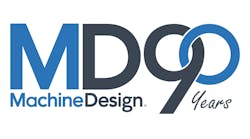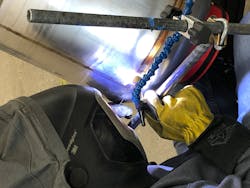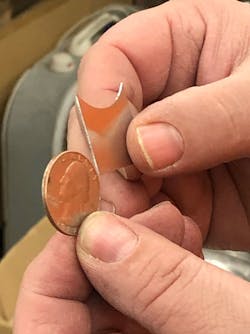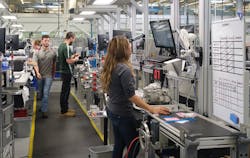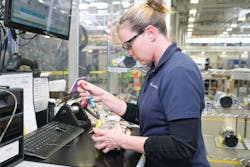Sagar Patel sees the future is taking off, and he sees taking off as the future.
As president of the aircraft turbine division of Woodward, a Rockford, Ill.-based manufacturer of aircraft turbine engines housings, his company’s near-term future is tied to the aircraft industry’s global expansion.
“The commercial aerospace fundamentals are driven by consumers. Middle-class growth in the world is forces a lot of people to travel for business,” Patel noted. “Meanwhile, global commerce drives growth on the freight side. The military side is always a heavy spender in the world. The fundamentals are there: Fuel prices are stable and airline ticket prices are pretty reasonable. Older airplanes are coming in for retirement. Aerospace is in a sweet spot. There are not many industries where growth is twice that of GDP.”
Teresa Beach-Shelow helped found Superior Joining Technology in nearby Machesney Park with her husband Thom Shelow a quarter-century ago with a simple aspiration to provide high-quality welding. A business that began in their garage has become a global leader in precision welding. The Shelows’ business has expanded into non-destructive testing, laser marking, and additive manufacturing, but it is their work as an AS9100-certified shop for the international aerospace industry that has found their work going up on NASA flights.
“We pay attention to all of those issues about compliance, high-end tools, and skills,” Beach-Shelow said. “We’re not casually AS9100 certified. We’re doing it every day, and that’s brought us the highest level of customers.”
Companies such as Woodward and Superior Joining Technologies are two of the dozens of companies that are part of an expanding aerospace hub in the greater Rockford area. Located on the interstate connecting Chicago and Madison, Wis., Rockford may at first seem an odd place for such a concentration of high-tech talent. Yet aerospace is part of the region’s DNA.
Sixty years ago, Sundstrand Corp. was a major aerospace supplier, and that lured many other aerospace companies to locate in the region. Today more than 90 companies supply components to the aerospace industry—the sixth-largest such concentration in the country. There are more than 250 aerospace companies within 90 minutes of Rockford—including Boeing’s corporate headquarters in Chicago.
There is a certain romance surrounding the aerospace industry. From the barnstorming flyboys of the Roaring ’20s to the fighter pilots of World War II to the Mercury 7 astronauts—and finally to the moon landing half-a-century ago—the pilots and explorers, as well as the ground crew and assembly line workers, are regarded as heroes and legends.
The machines they flew are every bit as essential to that aura of romance and excitement. As the next generation gears up to travel and look further into space, companies such as those in Rockford are turning technologies into the tools and vehicles for exploration.
Cooperation a Key
Logistics and history have helped strengthen the region’s aerospace manufacturing and transformed much of Rockford’s legacy firms into high-tech incubators. It also is a collaborative process; the region’s aerospace firms got together to form the Rockford Area Aerospace Network, a support group for aerospace companies.
“In the Rockford region, we have iron, aluminum…just about anything we need,” says Jim Clark, production manager at Clinkenbeard, which manufactures castings in South Beloit, just up the road from Rockford. “Parts don’t leave this town too much. I very rarely have to leave town to get a lot done.”
Clinkenbeard’s expertise is in what Clark called “product realization”. The firm can complete castings in as little as four weeks for aerospace partners in the area. “The bulk of our business is low volume,” he said. “Quick turns win the day. Our job is to compress that timeline even more.
“We’re very streamlined here,” Clark continued. “When I do quoting, I already know how we’re going to build it. You just don’t let anything sit in an inbox. High quality and low volume—we’ve found that niche in the market.”
Ingersoll Machine Tools is another company that benefits from Rockford’s aerospace markets. It also has reinvented itself a few times. The sprawling campus that once housed 2,000 workers has a dramatically smaller workforce after emerging from bankruptcy in 2003.
Today Ingersoll Machine Tools has three distinct business units on the leading-edge of technology. “Our primary focus is building machine tools, and that part of the business is split between metal cutting and process materials,” said Ingersoll CEO Chip Storie. “The second business is composites and 3D printing. The third is contact machining. We build our own machines and use them to make parts for primarily defense, space, and heavy equipment customers. Customer supply raw materials and we machine them to the finished form.”
That business model has put its finished works on NASA flights, airplane wings, and soon on the world’s largest Earth telescope. The Giant Magellan Telescope will be built in Chile by a German company, with Ingersoll handling all the machining for the project.
The company also has built the largest 3D-printed part, a full-scale boat constructed in 72 hours for the University of Maine.
Ingersoll’s advancements in 3D technology have emerged from its work on defense projects. “We’ve enjoyed the boom in the defense department,” Storie said. “There have been a lot of really neat parts that have come through the door. It’s been a learning process doing more defense work and managing all the regulations.
The use of carbon fibers in aviation is one example. “The technology really got going in the Defense Department with the Stealth Fighter and B2 bomber,” Storie said. “As often is the case, the origins in defense bleed over to other applications. It started out with the stealth aspect, but the side benefit was that parts also weighed a lot less.”
Superior Joining Technologies is another business that has seen its Rockford-based work wind up in space, where its expertise in precision welding leaves no margin for error, even in the thinnest welds imaginable. “About 85% of our business is in aerospace,” Beach-Shelow said. “We’re very much an international company,” she said. “We’re much more than a local company. Most of our sales dollars come from outside the region. But the key to our success is the strength of the supply chain in this region.”
Rebound in Rockford
For the last half of the 20th Century, Rockford was a symbol of the decline in the traditional manufacturing base. Once the state’s third-largest city with nearly 150,000 residents, Rockford suffered from an exodus of manufacturing jobs. As businesses left, the downtown infrastructure crumbled, services diminished, and unemployment soared. In January 2010 at the height of the Great Recession, unemployment hit 17.4%.
That was followed by a recommitment to regional growth built on one of the region’s continuing strengths—the aerospace industry.
Woodward was among the leaders, committing to construction of a sparkling new campus in neighboring Loves Park. But it wasn’t just a sentimental decision—Woodward’s expansion was driven by the need to meet the demands of a burgeoning aerospace industry.
“Woodward always has been a great design company,” Patel said. “Now we have grown into a great process innovation company. We can connect the whole system. We do design and testing and then put the production line in place. That gave us a great investment opportunity.”
The challenge of developing a workforce faces every manufacturer today. In a community recovering from double-digit unemployment, new approaches were needed. “With our growth, we were forced to think differently,” said Patel. “We laid out a 10-year plan for hiring and training and worked with Rock Valley Community College to put together a program for high school grads.”
The growth pattern for Woodward also drives a more liberal approach to skill set assessment. “If we can get a high school grad or someone who works at Subway or a junior college student or anyone in between, we should be able to train them,” Patel said. “Regardless of the skill set they have, they will progress rapidly if they are willing to learn. Even those with a slower learning pace can find a good position if they are willing to learn.”
“We hire based on two things: attitude and aptitude,” Patel added. “As long as they are willing to learn, we are a learning culture.”
For companies with talents stretched thin, Ingersoll Machine Tool has altered its business model to provide help. Its machine tools have sensors that let operators monitor the equipment health, but Ingersoll will also provide monitoring and servicing as part of the contract, as well as remote monitoring.
With its in-house machining business, Ingersoll can turn the capital expenditure of a customer’s new machine tool into an operational cost of doing the machining offsite. “We can supply services to customer and get closer to them, which lets us work hand-in-hand to determine how customer wants to run the machine,” Storie said. “Many companies are not adept at doing ROI calculations. We can help them justify putting together a capital expense plan.”
Superior Joining Technology also sees the value of being creative in attracting workers. “We’ve involved in the community and our brand is well known, so we have a lot of interaction with young people,” says Beach-Shelow. “We sponsor high school robotics and Lego teams and support the Quiz Bowl on local TV station where high-school students compete.
“Name recognition is important,” she added. “We give many, many tours of the plant. We try to create a work environment that makes employees want to stay. More than half of our workers are 45 or younger. Strategically, that has been a goal. We always have an 18- or 19-year-old in training.”
The aerospace industry is guiding Rockford back to vitality. Unemployment has plummeted by two-thirds in the last decade to where it is now below 5%.
“3D printing puts us in the forefront of most industries,” Beach-Shelow said. “Every customer is saying to engineers, ‘Do an analysis of 3D metal printing vs. traditional design’ and every customer is asking ‘How can we combine traditional and non-traditional manufacturing?’ ”
“The next frontier is leveraging what we see as the digital twin,” said Patel. “We have barely started tapping into its potential. We can pull up a model of an entire plant and see what our capacity is. From there, we need to know how to connect all those dots.
“The technology is there. The know-how is there,” Patel added. “Whoever solves that problem will differentiate themselves in the world.”
